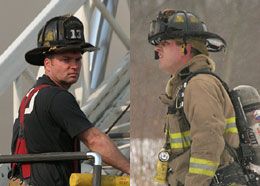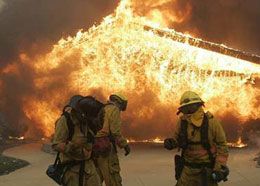 Photos Tod Parker Rehab needs to be considered in both hot and cold weather. |
Fire Incident: A task force is assigned for wildland firefighting. The group will report to area command for an operation likely to last seven to 10 days. Firefighters are requested to bring necessary provisions for a two-week stay. All hands will be working the first few days at the interface areas to protect homes that are threatened. The weather has been hot and dry, with windy conditions. No precipitation is forecast until about seven days into the assignment.
The task force prepares for deployment and lands in the area the next day. The briefing includes the elements necessary for firefighters to maintain a high level of physical activity for a week or more. The length of operation is a known challenge for firefighters and requires a program on ongoing maintenance of sleep, fluids and calories. There are key lessons to learn for each firefighter, regardless of their usual activity or assignment. Fire rehabilitation activities for the urban firefighter can be built on the principles of professional athletes, military personnel and other workers with extreme physical stress. Peak physical performance in any of these workers is facilitated by long-term programs of physical fitness and programs that replenish key physiologic elements after periods of extreme activity. This is the basis for fire rehabilitation programs.
Fire rehabilitation is the act of providing evaluation, hydration, nourishment and rest to personnel working at the scene of an emergency operation or training exercise. When emergency responders become fatigued, their ability to operate safely is impaired. Reaction time is compromised and their ability to make critical decisions diminishes. Department leaders and incident commanders must ensure that the physical and mental condition of members operating at the scene of an emergency or training exercise does not deteriorate to a point that it affects the safety of each member or jeopardizes the safety and integrity of the operation.
Program principles used by wildland firefighting teams have long been applied by departments operating for long periods of time in stressful environments. This may apply to hot weather, during weeks of very active physical training or in prolonged rescue and recovery operations from a major disaster.
Rehab operations should be used at the scene of an emergency operation or training exercise when strenuous physical activity is involved or there’s exposure to heat and cold conditions. The rehab operation in prolonged operations may even use a couple of tools not routinely utilized in patient care or firefighter fitness programs: an accurate bathroom weight scale and urine dipsticks can provide valuable information to the firefighter and to those officers overseeing the rehabilitation operation.
For instance, an accurate weight scale can monitor an individual firefighter for fluid loss. A liter of water weighs 2.2 pounds, while a gallon of water weighs 8.3 pounds. A firefighter weighed on consecutive days should maintain a similar weight, or dehydration should be suspected. Clearly, some weight loss may occur as calories are burned and not replenished, but a weight loss of more than 2-3 pounds per day indicates dehydration and the need for fluid replacement.
In addition, urine specific gravity is another way to measure the hydration status of an individual and is probably the best indicator in healthy individuals with good kidneys. There are different methods to measure specific gravity, but the simplest is the urine dipstick. The individual collects urine in a container, the dipstick is placed in the container, and following the manufacturers’ instructions, the level of specific gravity is indicated within a minute on the paper. High values for specific gravity mean very concentrated urine and that the person’s kidneys are working hard to preserve water. So, high specific gravity values indicate dehydration.
Hydration status
Those who oversee athletes use this method to assess hydration status and we can utilize their guidelines to assist in monitoring firefighters over periods of physical activity. The National Collegiate Athletic Association (NCAA) selected a urine specific-gravity measurement of ≤1.020 to indicate normal hydration. Wrestlers with a urine specific gravity ≤1.020 are considered normally hydrated and may have their body composition assessed to determine their minimal weight for competition, whereas wrestlers with a urine specific gravity >1.020 are considered to be dehydrated and may not proceed to body-composition testing on that day.
Firefighters or rescuers being tracked for dehydration over a period of days should be able to maintain weight and maintain urine specific gravity under 1.020. In addition, another element of a urine dipstick is its use in monitoring individuals performing heavy physical activity over time. Ketones appear in the urine if the patient has not had sufficient calorie intake and urine ketone measurement is part of all standard urine dipsticks. The normal individual has zero urine ketones.
The introduction of a pulse co-oximeter has allowed rehab officers to monitor exposure to carbon monoxide. Firefighters with too much exposure to products of combustion have levels of carboxyhemoglobin of more than 5 percent, and that level may be associated with poor judgment, headaches, shortness of breath, nausea, vomiting and dizziness. Wildland firefighting is done without breathing apparatus, so there is ongoing and uncontrolled exposure to smoke. But exposure to carbon monoxide producing high levels of carboxyhemoglobin may cause immediate problems and must be monitored to prevent illness or injury to the firefighter.
A sample set of medical orders for firefighters operating over time in hot environments might include these elements:
Heat cramps/exhaustion
1. Obtain and record vital signs, including carboxyhemoglobin level by co-oximeter
2. Begin gradual cooling:
a. Move patient out of hot environment. Remove as much clothing as possible to facilitate cooling.
b. Soak towels or sheets with cool water and place on patient. Do not cause patient to shiver.
c. Consider need for oral fluid and salt replacement (i.e. Gatorade).
3. Establish IV NS with 500cc bolus if patient is too nauseated to drink.Can repeat NS boluses up to 2 liters total.
4. Pulse rate must recover to a rate below 100 beats per minute
5. Obtain a urine specimen for testing. If the urine specific gravity remains more than 1.020, the patient is still in need of hydration. If oral liquids are not tolerated at that point, it is probably time to head to the hospital.
 AP Photo/Lenny Ignelzi Firefighters brace themselves from explosive heat coming from a burning home during last year’s SoCal wildfires, which saw firefighters on the frontline for long durations. |
Heat stroke
1. This is the likely diagnosis if the patient has altered mental status, including confusion, combativeness and disorientation. Immediately remove patient to cool environment.
2. Begin rapid cooling procedure. Remove clothing to shorts. Apply cold compresses to axilla, neck and groin. Spray body with cool water and fan the patient, but prevent shivering. If the person vomits, place patient on their side to maintain airway and prevent aspiration.
3. Obtain vital signs, including carboxyhemoglobin level by co-oximeter, and temperature if available. Respiratory distress, a temperature of more than 106 F, a pulse rate of more than 180 beats per minute or a carboxyhemoglobin level of more than 10 percent requires immediate transportation of the firefighter.
4. TRANSPORT if altered mental status not resolved in five minutes.
5. Slowly allow oral fluid intake of cool or room temperature fluids, maintaining the patient on their side. If the patient is vomiting, it will require the start of an intravenous line and bolus with fluids. Start with 500 cc of normal saline.
Nausea and vomiting, not tolerating oral fluids
1. Obtain vital signs, including carboxyhemoglobin level by co-oximeter
2. Initiate IV NS at 200 cc/hr. It is appropriate to administer fluids in 500 cc boluses
3. If patient is still nauseated, administer a medication for nausea, either IV or in suppository form.
4. When nausea decreases, trial with oral fluids.
5. Obtain a urine specimen for testing. If the urine specific gravity remains more than 1.020, the patient is still in need of hydration. If oral liquids are not tolerated at that point, it is probably time to head to the hospital. If ketones are positive, the patient is also lacking sufficient caloric intake.
6. If desired effect is not seen within 60 minutes, consider hospital removal or contact medical control for further orders.
Fire incident management
This wildland and interface firefighting operation was exhausting work for all crews. Their efforts saved numerous exposed homes. Firefighting operations encompassed a wide area and it was necessary to establish multiple rehab areas. The common rehab needs in a wildland fire incident were provided:
- Shelter to include seating, with cooling capability, shaded areas and sunblock
- Fluid and calories
- Equipment rehabilitation, especially those elements of protection from insect stings, poison ivy, and falls
- Health evaluation and therapy
- Mental decompression
Homeowners and rehab officers provided domestic sources of water and cooling for crews working close to domestic structures. But because firefighting operations were widely scattered, the basic health management principles listed above were applied for all firefighters working the incident. Firefighters underwent weight testing and urine dipstick testing each morning, and the firefighter could not return to operations if:
- Weight had dropped more then 3 pounds from the prior day
- Urine specific gravity was more than 1.020
- Urine ketones were positive
The firefighter could remain in the staging areas for hydration and calorie intake, and if the values remained abnormal by noontime (or the person had other medical complaints), the individual was referred to a clinic, emergency department or a primary physician for evaluation. Only one of those medical providers could then release the individual back to operations.
The incident was managed without major injury or illness to fire personnel. The firefighters were impressed with the consistent approaches to health and safety, despite the wide area and scope of operations.
In major incidents such as these, fire rehab operations improve the ability of the firefighter to work today’s incident, but also and maybe more importantly, the rest of the week and then safely to return home.
Incident rehab requires leaders to address many challenges to maintain a safe work environment, no matter where or when the incident occurs. A firefighter must maintain his/her long term physical fitness to match the many physiologic challenges of fire and rescue duties.
This combination will produce the long-term goal: be a healthy retiree!











